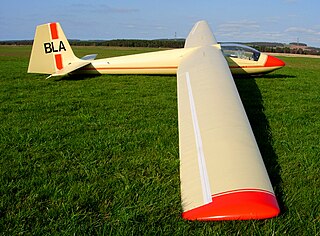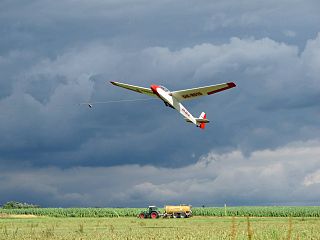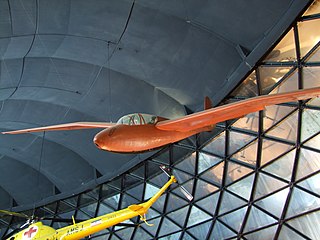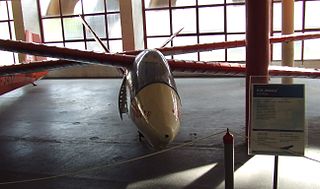Related Research Articles

The Schleicher K 8 is a single-seat glider designed by Rudolf Kaiser and built by the Alexander Schleicher company of Germany.

The Aer-Pegaso M-100 was a single-seat glider designed and built in Italy from 1967.

The Antonov A-13 was a Soviet aerobatic sailplane flown in the 1950s and 1960s. It was a small, single-seat, all-metal aircraft developed from the A-11 which could optionally be fitted with that aircraft's longer-span wings. It was a mid-wing monoplane with a tadpole-like fuselage and a V-tail.
The Schneider ES-59 Arrow is a sailplane designed and manufactured in Adelaide, South Australia in the early 1960s. The Arrow was manufactured with a one-piece wing of 13.23 metres span. It was the first Australian-built sailplane to compete in the World Gliding Championships, 1963 in Argentina. The Arrow has wood/fabric wings and tail and a wood fuselage. It has a fixed main wheel and nose skid.

The Slingsby Type 42 Eagle was a two-seat glider designed in England from 1952.

The Slingsby T.6/T.23 Kirby Kite was a single-seat sport glider produced from 1935, by Fred Slingsby in Kirbymoorside, Yorkshire.
The Slingsby T.25 Gull 4 is a British glider designed and built by Slingsby that first flew in 1947.

The Scheibe Bergfalke is a German glider designed by Egon Scheibe as a post-World War II development of the Akaflieg München Mü13 produced before and during the war.

The Slingsby Type 45 Swallow was designed as a club sailplane of reasonable performance and price. One of the most successful of Slingsby's gliders in sales terms, over 100 had been built when production was ended by a 1968 factory fire.

The Slingsby T.50 Skylark 4 was a British single seat competition glider built by Slingsby Sailplanes in the early 1960s. It sold in numbers and had success at national, though not world level competition.

The N.V. Vliegtuigbouw 013 Sagitta is a Dutch mid-wing, single-seat Standard Class glider designed by Piet Alsema and produced by N.V. Vliegtuigbouw.

The Schleicher K7 Rhönadler, aka Ka-7 or K-7, is a West German high-wing, two-seat, glider that was designed by Rudolf Kaiser and produced by Alexander Schleicher GmbH & Co.

The Wassmer WA-30 Bijave is a French two-seat advanced training glider designed and built by Wassmer Aviation of Issoire.

The Ikarus Košava is a two-seat sailplane designed and built in Yugoslavia in the early 1950s. It won the 1954 World Gliding Championships in the two seat category and came second in the same event two years later.

The Rubik R-25 Mokány, in English: Plucky person and sometimes known as the R-25 Standard (class), is a Hungarian single seat Standard Class glider of all-metal construction, first flown in 1960. It was one of a series of similar aircraft designed by Ernő Rubik. Only one was built.
The Horikawa H-23B-2 is a two-seat training glider designed and built in Japan in the 1950s. It was produced in small numbers.

The Antonov A-11 is a single-seat, high performance, all-metal sailplane built in the Soviet Union in the late 1950s. 150 were produced.
The UTG-1 Loudon was an intermediate glider designed and built at the University of Toronto in Canada during the late 1940s.
The IS-2 was an intermediate training glider designed by Iosif Şilimon and built in Romania in the 1950s at the URMV-3 factory at Brașov.
The IS-4 was a high performance glider designed by Iosif Şilimon and built in Romania in the late 1950s at the URMV-3 factory at Braşov.
References
- Shenstone, B.S.; K.G. Wilkinson (1963). The World's Sailplanes:Die Segelflugzeuge der Welt:Les Planeurs du Monde Volume II (in English, French, and German) (1st ed.). Zurich: Organisation Scientifique et Technique Internationale du Vol a Voile (OSTIV) and Schweizer Aero-Revue. pp. 34–36.
- Hardy, Michael (1982). Gliders & Sailplanes of the World. London: Ian Allan Ltd. p. 62. ISBN 0 7110 1152 4.
- Partington, Dave (2010). European registers handbook 2010. Air Britain (Historians) Ltd. ISBN 978-0-85130-425-0.
- Shenstone, B.S.; Wilkinson, K.G. (1963). The World's Sailplanes. II (1st ed.). OSTIV & Schweizer Aero-Revue. pp. 38–9.
- "Kometa-Standard" . Retrieved 17 September 2012.